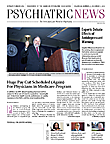Though large population-based surveys by government agencies and academic institutions report high and sometimes rising rates for substance use disorders (SUDs) such as alcohol and opiate dependence, these disorders are too seldom treated with pharmacotherapies approved by the Food and Drug Administration (FDA), some addiction experts maintain.
This fall, leading clinicians and researchers in addiction psychiatry provided insight on issues and trends regarding use of illicit drugs, including medications to treat them, at APA’s Institute on Psychiatric Services in San Francisco.
“For a while, until 2000, the United States was seeing a marked decrease in heroin use” that spanned a period of nearly 10 years, said Petros Levounis, M.D., M.A., chair of the Department of Psychiatry at Rutgers New Jersey Medical School, at the symposium. “Then we had the explosion of prescription opioid use, which became an epidemic.”
According to the Centers for Disease Control and Prevention, from 1999 to 2008 there was a dramatic increase in deaths due to overdose of prescription painkillers that paralleled the 300 percent increase in sales of the potentially addictive opioid receptor agonists. In 2013, the National Survey on Drug Use and Health showed that heroin use more than doubled over a five-year span, with 669,000 people in the United States reporting current heroin use in 2012, compared with 373,000 in 2007.
In an interview with Psychiatric News, Levounis stated that because heroin has become less expensive, and sometimes easier to acquire, than prescription opiates, heroin has become the drug of choice for some addicts and accounts for the rapid spread of its use throughout the country in the last few years. This shift is also blamed for a large increase in the number of people showing up in emergency rooms suffering from heroin overdoses and needing addiction treatment.
Levounis noted that there are currently three pharmacotherapies to treat opiate dependence that have been approved by the Food and Drug Administration (FDA)—methadone, buprenorphine, and naltrexone/naloxone—and stressed that “there is no ‘one-size fits-all’ treatment, … [and] efficacy of the treatments may vary from person to person.’ ”
Levounis pointed out that there are no “new” medications in the drug-development pipeline to treat opioid addiction, but there are newer formulations of FDA-approved drugs, such as probuphine, which is an implantable, long-injection version of buprenorphine that helps patients adhere to their addiction-treatment regimen.
Other topics discussed at the symposium included treatment of alcohol use disorder (AUD) and certain types of stimulant use disorders.
“Pharmacotherapies for AUD are highly underutilized. Only 8 percent of adults with AUD are currently being treated for the illness” with these medications, said Steven Batki, M.D., a professor of psychiatry at the University of California, San Francisco, who pointed out that there is no universal treatment that is as effective in all patients with AUD.
“There is a lot that goes into prescribing the best medication for an individual patient,” Batki said. “We have to ask patients if they are abstinent [from drinking], currently drinking, … on an opioid or not on an opioid, … and whether they have liver disease.” Batki stressed that asking patients these questions is critical to reducing the risk for potential multidrug interactions and adverse events. Currently, he noted, there are three FDA-approved medications for AUD—disulfiram, naltrexone, and acamprosate.
Larissa Mooney, M.D., an assistant professor of psychiatry at the University of California, Los Angeles, provided an update on trends in cocaine and methamphetamine use and the medicines used to treat addiction to those drugs. She pointed out that there are no FDA-approved medications for these addictions, but other FDA-approved drugs such as mirtazapine, bupropion, and naltrexone are being studied in clinical trials as potential therapies for methamphetamine addiction, as is a vaccine for cocaine use.
Giving her perspective on the symposium, Mooney, who also served as its chair, told Psychiatric News that since drug addictions are very common disorders in both general and psychiatric patient populations, she hoped the session succeeded in “conveying some important messages about the treatment of addiction” that psychiatrists could take home and use in their practices. ■
